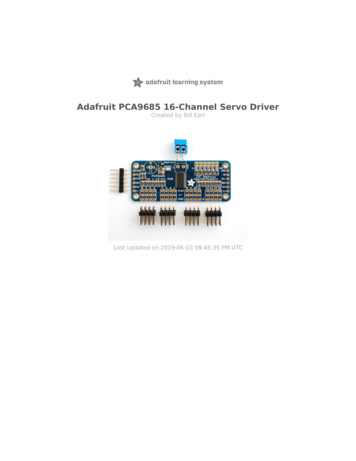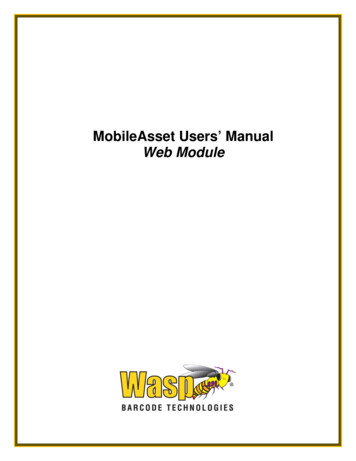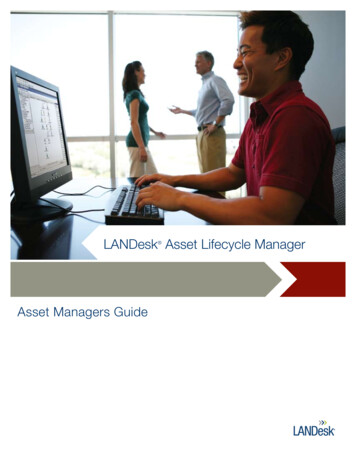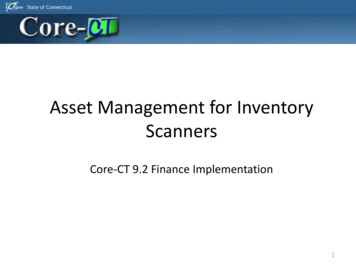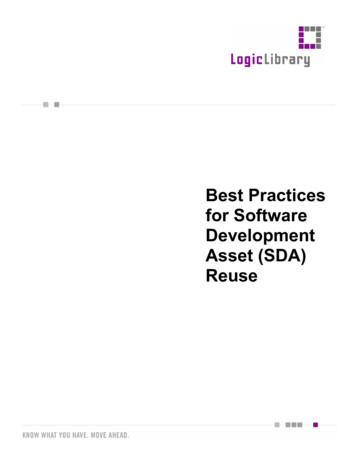
Transcription
Best Practicesfor SoftwareDevelopmentAsset (SDA)Reuse
Best Practices for Software Development Asset (SDA) ReuseIntroductionEveryone agrees that reuse of software development assets (SDAs) is a“good thing” and that service-oriented architectures (SOAs) requireorganizations to institutionalize services as reusable assets.Nonetheless, there is considerable debate within IT organizations asto how to “get from here to there” – i.e., how to move from thecurrent state of IT project development, with its emphasis onimmediate, time-driven project objectives, to “SOA nirvana” dfromrequirements driven by core business processes, meet near-termobjectives and facilitate strategic business enablement. Not an easytask, but it is possible to move towards this goal incrementally SDAproduction, distribution and consumption.Some TerminologyTo set the stage for the discussion, let’s begin with definitions forSDA and SOA.SDAs: Knowledge Assets and Executables with Maintainability,Discoverability and ConsumabilityWhat is an SDA?Simply put, it is “something of value to an ITorganization.” This definition is generic for a reason: developmentassets are so wide-ranging that an all-encompassing definition mustbe necessarily vague; however, it can be clarified by example.Within the world of SDAs, there are two major types of assets:knowledge assets and executable assets. Knowledge assets consist ofinformation used by the IT organization to do its work moreconsistently, efficiently and effectively.Examples of knowledgeassets include architectures, design patterns, processes, templates,etc. Executable assets are the things most technical people think ofwhen discussing reuse: components, services, APIs, schemas and otherdeployable packages.SDAs of both types are meant to be reused, sospecial care must be taken in their production. 2005 LogicLibrary, Inc.2
Best Practices for Software Development Asset (SDA) ReuseWhat makes an asset reusable?For example, does a J2EE componentbecome an asset simply by providing its jar file?Probably not,unless the component’s functionality is extremely simple and veryobvious.While the deployable jar is a very important work product(i.e., artifact) of the software development process, it does notmake the component an asset in and of itself. In order for somethingto be considered an asset to the IT organization, it must bemaintainable, discoverable and consumable. Maintainability introduces such concepts as version control(discussed in more detail below), models and other designdocumentation, as well as requirements traceability (why theasset was implemented in this way from a technical and businessperspective).Discoverability means potential consumers of an asset can findit in a timely fashion – for example, via keywords, domaintaxonomies or models to which the assets are mapped.Consumability involves looking at an asset from the point ofview of a future project that might use the asset: are a userguide, a well documented API, sample client code and otherartifacts available to help the user rapidly understand how toapply the asset to a project? Are dependencies to other assets(and to prior versions of this asset) specified and easilynavigated?The process of building an asset creates metadata that represents theasset – describing the asset from various points of view.Thismetadata presents a composite view of the asset across its entiredevelopment and deployment lifecycle, with indexes (or references)into the various point tools that hold the work products associatedwith the asset, such as document management systems, requirementsmanagement systems, version control repositories, defect trackingsystems, test automation tools, etc. 2005 LogicLibrary, Inc.3
Best Practices for Software Development Asset (SDA) ReuseSOA Key Concepts: Core Application Functions, Coarse-Grained Servicesand Message-Oriented InfrastructureFor a concept that has probably reached the peak of its hype cycle, asurprising amount of debate and confusion over what constitutes aservice-oriented architecture continues to exist.Much of thisdebate tends to get stuck in technical details, perhaps because thetechnology infrastructure most frequently associated with SOA - Webservices – is still maturing as standards evolve and organizationslike WS-I define preferred interoperational modes of servicedeployment.In short, conversations about SOA seem to stall at thetechnical level because Web service technology remains in flux.Looking beyond pure technology, some core concepts rise above thetechnical muck to help define the fundamentals of a service-orientedarchitecture.An SOA provides for the definition and delivery ofcore application functions through a series of ssage-orientedinfrastructure.Enabling Core Application FunctionsFirst, an SOA must support the delivery of core applicationfunctions.To clarify, this is not a comment about releasingapplications. It is a statement about enabling a development processthat delivers business value by being flexible and responsive sohigh-quality applications are delivered faster, for better serviceand competitive advantage. An SOA must yield appropriately decoupledservices that can support multiple applications – both end-user(customer, partner, and internal) and machine-facing – withoutservice reimplementation.Services must be reusable without majorrework, or they just add Yet Another Layer Of Technology (YALOT) toan already messy technical infrastructure.Coarse-Grained Services – “Right-Sized” for Application AssemblyServices within an SOA must be sufficiently coarse-grained to enablemeaningful assembly of applications.Right-sizing services for thispurpose is one of the more challenging issues facing architectureteams instituting an SOA.At one extreme, services which support 2005 LogicLibrary, Inc.4
Best Practices for Software Development Asset (SDA) Reuse“get customer’s middle name” (for example) are far too nyresultingapplications built from such services will perform abysmally), gbusinessprocesses, such as “close accounting books for fiscal year,” are toobroad and completely impractical to implement. Finding the rightmiddle ground of services that can support multiple businessprocesses with appropriate granularity is probably the biggestchallenge to an IT organization.Tying Services Together with a Message-Oriented InfrastructureServices are of no use if they cannot be consumed within actualapplications.Tying them together into business process flows hanorchestration engine of some sort maintaining the long-runningprocess state.Getting to “SOA Nirvana”With terminology established, it is time to discuss how anorganization can begin to roll out an effective SOA strategy.Thisconversation does not start with the bits and bytes of SOAinfrastructure.Such an infrastructure is clearly necessary as atechnology underpinning to support a deployed SOA, but it isinsufficient as a guide for SOA definition and development. The mostappropriate place to start the dialogue is with proper architecturaland project governance, which is required to “put your IT house inorder.”These processes prioritize the development of serviceswhile keeping the broader objectives of SOA in mind.They alsoensure that services are built with sufficient security, quality find,understand and register their use of the services in application andbusiness process integration projects.All of these objectives fit under the umbrella of “SOA governance,”the means by which enterprise architecture teams oversee IT 2005 LogicLibrary, Inc.5
Best Practices for Software Development Asset (SDA) Reusedevelopment projects and IT project teams provide feedback on thatguidance.Within this “big-animal” governance lifecycle, a supporting on,assetdistribution, and asset consumption. 2005 LogicLibrary, Inc.6
Best Practices for Software Development Asset (SDA) ReuseThe remainder of this paper discusses five best practices within theasset-reuse lifecycle.Asset Reuse Best PracticesBest Practice #1: Pragmatic Service Interface Modeling and DefinitionGoing back to the original definition of SOA, one of the key aspectsof an SOA is that the services defined and deployed within thearchitecture must provide core application functions to potentialconsumers.This is easier said than done.Services within an SOAcannot be effectively developed in a “bottom-up,” ad-hoc manner.Bottom-up development of services is inherently driven by immediateproject needs – how do I solve this specific problem with a existingapplications and their behaviors masquerading as true businessrequirements).What happens when an organization defines andimplements its services with this mindset? The service layer simplybecomes YALOT – more spaghetti code that implements a monolithicapplication in a different technology instead of improving businessprocess flexibility.But, services also cannot be defined solely in a “top-down” manner.Top-down business process analysis left to its own devices oftenleads to one of two outcomes: “analysis paralysis,” continualrefinement of a model hoping to reach perfection (which never comes),or “Big-Bang” projects that try to “boil the ocean” – defining andimplementing everything at once, usually with disastrous consequences(“death march” projects, schedule slips and/or cost overruns).So where to go from here? The objective is to design and implementbusiness services that support the immediate project’s requirementswith enough flexibility to meet future business process needs, bothprojected and unknown. This is a pretty stiff challenge and one thatis not likely to be met in a single step. In reality, there must be apragmatic balance between where the business is and where it needs togo, moving services towards the objective in iterations. 2005 LogicLibrary, Inc.7
Best Practices for Software Development Asset (SDA) ReuseThese iterations should move the service towards the goal of buildinga coarse-grained business architecture (or model).The coarsegrained business model should be driven by key business ityprocesses).Architects and business analysts should use these processes toextract and define a normalized set of functions that are groupedtogether based on behavioral affinity (or, in UML terms, componentsand interfaces) to create a straw-man set of initial, targetdefinitions for the services.This effort creates a roadmap forprioritized service definition and development. comp spec Order SystemOrderMaintanance comp spec Shipping thod ManagementImportSalesTaxCalculationReporting comp spec CreditCard Handler comp spec Analytical System comp spec SalesTaxCalculatorPaymentsVerification comp spec FinancialAccountingSales TransactionPredictionFinancialReporting comp spec Currency ExchangeSystemConversionCurrencyMaintananceHas the exact set of services and operations been defined as a resultof this top-down modeling activity?Of course not, but it hasproduced a starting point for the real work – the detailed analysis,design and implementation of the services necessary for the currentset of prioritized projects. The needed services are identified fromthe business reference model, based on business process (and project) 2005 LogicLibrary, Inc.8
Best Practices for Software Development Asset (SDA) Reuseprioritization, and their definitions are formalized.Ideally, eachservice definition should be driven by the requirements extractedfrom at least two separate processes. Otherwise, designing a servicebased on a single use case will probably result in a fragile,narrowly-defined service that will not be flexible enough to meet theneeds of the next set of prioritized projects.Formalizing servicedefinitions may lead to modifications in the reference model,including the identification of new services – which is just fine!This is the first step in iteratively refining the businessarchitecture.Once the service interface is specified, project teams can proceedwith detailed service design and implementation.Often, this meansassessing the current set of production applications to understandwhich aspects of the applications are candidates to support plicationcapabilities by implementing adapters that provide the necessary glueand compensation logic.Usually, these adapters are implementedbehind a component façade which may have been generated from theoriginal service definition, as specified in WSDL (or, alternatively,service operations may have been defined as methods on a componentinterface, with a WSDL document and service client proxy codegenerated from that starting point).Best Practice #2: Production Lifecycle Review PointsAs mentioned above, we need to ensure that the defined andimplemented services are properly aligned with the enterprisearchitecture, use correct implementation techniques and technologies,and provide enough supporting information to enable potentialconsumers to rapidly discover and understand them.How is thisaccomplished? By applying appropriate review points in the softwaredevelopment lifecycle (SDLC) and defining a virtual/matrixed SDAarchitectural review team to complete these reviews. 2005 LogicLibrary, Inc.9
Best Practices for Software Development Asset (SDA) ReuseWho should be on this review team? ization whose dedicated responsibility is building asuccessful SDA reuse program.Matrixed team members drawn from participating project teams.The members should have lead designer/developer skills, andtheir work on this team should be recognized and allocated as10%-20% of their job responsibility.Assignment to this teamshould be promoted as a talent-recognition award and a growthassignment for the individuals involved.A rotating membership(perhaps six to 12 months in duration) serves to train youngerdevelopers in architectural principles and then allows them tocarry that knowledge back to their project teams, increasing theoverall skill level of those teams.Consideration should also be given to including members from essfunctionality defined by a service truly reflects the enterprise’srequirements.The primary responsibility of the team is to review services underdevelopment. The objectives of this review will vary depending uponthe stage within the SDLC to which a particular service hasprogressed.At a minimum, it is recommended that organizationsreview services under development at the following points in theSDLC: Requirements complete: All business requirements are documentedand the initial service definition has been specified (ideallyas WSDL) so reviewers can validate the service against itsbusiness architectural context.Design complete: The implementation approach has been odelscompleted, relevant legacy APIs identified) to allow lication/integration architectural contexts. 2005 LogicLibrary, Inc.10
Best Practices for Software Development Asset (SDA) Reuse Implementation complete: The service has been implemented anddeployed in a test environment, with sufficient supportingdocumentation (e.g., sample client code, automated/manual testcases and test results, usage guide) to enable a potentialconsumer to understand the service and trust its quality andstability.Other review points may also be appropriate based on organizationalneeds and objectives.However, do not overwhelm development teamswith process for the sake of process.They will quickly revoltagainst jumping through seemingly arbitrary hoops.The objectiveshould be “just enough process” to provide appropriate guidance atkey points in the production and consumption lifecycles to keepthings on track.Just as right-sizing a service may be iterative,finding the right level of process control for the organization maybe iterative also. Consider starting with as “light” a process as isfeasible and adding more process steps only as needed.Appropriate tooling can greatly assist organizations in effectivelydeploying their governance processes. In fact, applying process toproduct in a pilot project is an ideal way to validate anditeratively refine the process.Industry expert Donald J. Reifer,when discussing how to implement a practical reuse program, states,“ using a pilot project to demonstrate the value added from a welldesigned and deployed infrastructure is highly encouraged. Pilotprojects force senior managers, middle managers and technologists todetermine how to take the technology and use it in concert with theorganization’s process under real budget, schedules and constraints.”1Once a service’s review has been completed, the team makes itavailable to the broader community. An asset metadata library can beof great assistance in this process since it provides automated assetvalidation and supports the steps in the review process ncludenotifications and audit trail functionality. After publication to a1Donald J. Reifer , “Implementing a Practical Reuse Program,” Component-Based Software Engineering, pp. 453-466 2005 LogicLibrary, Inc.11
Best Practices for Software Development Asset (SDA) Reusemetadata library, potential consumers are free to discover theservice and its capabilities, provide feedback and incorporate theservice into their development projects.It is likely that implementing an SDA review team will have some veryuseful side effects.Forming such a team can break downorganizational barriers, helping to mitigate any potential politicalissues associated with a reuse initiative. Simply put, creating thistype of team can eliminate the “us vs. them” mentality that oftenoccurs when governance organizations and top-down processes areimposed on development organizations. The review team also is likelyto discover additional opportunities for reusable services (andenhancements that make existing services more robust and reusable)through their informal communication. This “active discovery” of newreusable capabilities can accelerate the creation and adoption ofservices within the SOA initiative.Best Practice #3: Managing Produced Services as Internal “Products”As services begin to roll out and are consumed within projects, anorganization will rapidly reach the point where the next set ofbusiness process requirements affects one or more of the existingservices.How will the new process be supported while preserving astable operating environment for existing service consumers? Becauseservices (like components) are meant to be used in more than entalenhancement of their services over a long deployment lifetime.Ineffect, organizations planning to build a robust, stable andextensible SOA need to treat their services as “products.”What does treatingorganization? aserviceasa“product”meantoanITEach produced service must have a regular and well-definedrelease cycle.This release cycle needs to occur often enoughto meet consumer needs on a timely basis, but not so often as tochurn existing consumers.Typically, a release cycle betweenthree and six months is appropriate for most organizations, 2005 LogicLibrary, Inc.12
Best Practices for Software Development Asset (SDA) Reuse allowing them to meet new service needs without undulydisrupting existing applications.Services must preserve backward compatibility wherever possible.Deprecation techniques provide time to migrate to newer servicereleases by identifying obsolete operations and notifyingexisting consumers that the operation will be removed fromfuture releases of a service interface (also known as “end oflife-ing” in product management terms).Service providersshould offer n-1 version support at a minimum – all dasdeprecated) should be preserved intact in the current version.In addition, consider providing a “grace period” where bothservice versions are supported so consumers can make anynecessary changes to integrate the updated service.Dynamicruntime binding techniques via a Web services -basedlatebinding) can also simplify the process of migration from anolder service to a new version.A mechanism must be established by the enterprise architectureteam and service-review team to gather new requirements andenhancements for services.Consider establishing a manageandprioritize the aggregate set of business requirements for aservice.The product manager should solicit feedback fromcurrent and potential consumers of the service, consolidatethose requirements and codify them (with the assistance of theenterprise architecture team) for eventual implementation byservice development teams.Treating services as “products” has a clear impact on SDLC tools usedwithin the development teams.Some examples of these impactsinclude: Version Control.Be prepared to establish a source codebaseline within the version control repository whenever a newversion of a service is released into production (or create athread label for later use as a baseline, if needed).The 2005 LogicLibrary, Inc.13
Best Practices for Software Development Asset (SDA) Reuse service-provider team must be able to simultaneously maintain aproduction service while developing the next version of aservice.Requirements Management / Defect Tracking. Organizations need articular service on a version basis, noting the versionagainst which the requirement or defect originated and thetarget version for resolution. Most requirements management mentation.SDA Management.Maintain all “valid” versions of a servicewithin the SDA library.At a minimum, consider defining theselifecycle states for the services:o “Under Development” – Only available for the cationdevelopment team. The service is not available for generaldevelopment use.o “Production” – Generally Available (GA) version for use innew development.o “Retired” – Still in use by existing applications, but notavailable for use by new applications.o “Obsolete” – All applications should be migrated from ability and audit purposes only.Best Practice #4: Delivering Web Services to Consumers via anIntegrated Asset Metadata LibraryAd-hoc Solutions Are Not EnoughAd-hoc distribution schemes may be sufficient for managing two orthree services used by a small community, and even that is debatablesince as long-term traceability is lost if organizations do notmaintain service usage records from initial service deployment.However, ad-hoc approaches do not scale to meet the needs of largerSOA and reuse initiatives. Spreadsheets and static Web sites used todistribute services rapidly become out-of-date.Verbal, “call thearchitect” approaches to communicating knowledge about available and 2005 LogicLibrary, Inc.14
Best Practices for Software Development Asset (SDA) mationbottlenecks.And, why build a repository and distract developmentteams from their core responsibilities when there is a proven,integrated, enterprise metadata library to buy?Building a homegrown library will also likely delay an SOA implementation and otherapplication development and integration projects.A Registry Is Not a RepositoryUDDI registries are just that – a means of registering deployedservices to enable operational late binding to one of many deployedservice endpoints using a specific service (e.g., for purposes offailover, scalability and geographic distribution).Any minimalrepository capabilities in a UDDI registry are a side effect, not itsintended purpose.In short, a UDDI registry is not explicitlydesigned as a repository so it does not provide the functionality ofa true repository.For example, a UDDI registry has limited searchmetadata and cumbersome search interfaces more suited towards runtimelook-up than human interaction; is not well suited to managing otherSDA types, such as components, legacy application APIs and knowledgeassets like design patterns; and is not well integrated into velopmentenvironment (IDE) tools.To summarize, a UDDI registry is not aviable solution for meeting serious metadata repository requirements.Checklist for an Asset Metadata LibraryUltimately, the objectives in selecting and deploying an assetmetadata repository/library are to effectively govern reusable assetproduction, to make it easy for potential consumers of the assets tofind them, and to track asset usage for purposes of changemanagement, impact analysis, and ROI determination.Accordingly,consider these important features when evaluating SDA libraries: Governed and configurable asset metadata assembly and validationo Standardized metadata definitiono Per-asset-type metadata validation and enforcementConfigurable (manual vs. automatic) asset publicationo Newly defined SDAs 2005 LogicLibrary, Inc.15
Best Practices for Software Development Asset (SDA) Reuse o Updated SDAso New versions of existing SDAso Organization-defined roles and review/approval processesPassive and active distribution modeso User-based SDA subscriptionso Automated search notifications during asset creation/updatingo Multiple search modesProject and asset-specific collaborationo Discussion forumso Persistent searcheso Asset notificationsMultiple UI optionso Thin-cliento Deep IDE integrationo API-based integrationBest Practice #5: Service Usage Traceability, Impact Analysis andReturn on InvestmentFast forward a bit.Services have been built and deployed that arewell aligned with the business architecture and business processneeds.They have been published into the asset metadata library soapplication development teams can easily find them.Now, the firstapplication projects are beginning to use the services. So the reuseinitiative is finished? Not quite One of the key objectives of anSOA is to create a flexible set of reusable services that grows overtime to support all of the key business processes. This growth willinevitably result in changes to services that are already deployed(as discussed in best practice #3), making it necessary to understandwho is using which assets.In other words, consumption activitiesneed to be scoped and tracked at a project level.Project-scoped, asset-consumption tracking allows for better controlover where services are being used, enabling several criticalactivities. With this level of tracking, a service-provider team caneasily inform consuming applications of service versioning, guide 2005 LogicLibrary, Inc.16
Best Practices for Software Development Asset (SDA) Reusefuture investment towards the most heavily used services, andcalculate the value of the dollar savings resulting from the reuse ofa service and other assets (i.e., determine a return on investment(ROI) for the reuse initiative). Each of the activities supported byconsumption tracking deserves further discussion.Depending upon the business, the structure of the developmentorganization, and other factors, an organization may need more orless control over the services being used by various applicationdevelopment projects.At one extreme, an organization may want toencourage broad-based reuse of a set of core services, even going sofar as to “pre-register” specific SDAs for a development team to use.At the other extreme, there may be certain assets which are highlysensitive due to privacy concerns, legal or compliance rules, tradesecret preservation and other rationales. Limited information may bepublished about such SDAs, restricting access to sensitive artifactsuntil the necessary approvals and compliance checks have beencompleted.The SDA library should support these widely varyingconsumption models through simple configuration settings.As discussed in best practice #3, effective versioning of services iskey to producing a viable SOA over the long term; however, wellmanaged versioning is meaningless if there isn’t a way to easily andautomatically inform service consumers when new versions are plannedand deployed so they can outline a graceful, controlled roject-basedconsumption within an SDA library provides the information necessaryto proactively manage downstream consumption of versioned services.In addition, early notification allows consumers to participate inthe requirements-gathering process for a new version.Tracking which SDAs are used where quickly creates a picture of wherefuture service development and maintenance are likely to be heaviest.After all, a service used by 10 different mainline applications ismore likely to require enhancements and defect fixes than one used bya couple of analytical reporting applications.This information isinvaluable to management for resource planning and allocation.Itcan also be used to recognize and reward service-production teams 2005 LogicLibrary, Inc.17
Best Practices for Software Development Asset (SDA) Reusethat are generating heavily usedconsuming a broad range of services.servicesandgroupsthatareFinally, since enterprises are in business to make profits, costsavings are often a major
The remainder of this paper discusses five best practices within the asset-reuse lifecycle. Asset Reuse Best Practices Best Practice #1: Pragmatic Service Interface Modeling and Definition Going back to the original definition of SOA, one of the key aspects of an SOA
